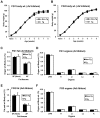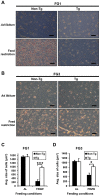Inhibition of lipolysis in the novel transgenic quail model overexpressing G0/G1 switch gene 2 in the adipose tissue during feed restriction
- PMID: 24964090
- PMCID: PMC4071008
- DOI: 10.1371/journal.pone.0100905
Inhibition of lipolysis in the novel transgenic quail model overexpressing G0/G1 switch gene 2 in the adipose tissue during feed restriction
Abstract
In addition to the issue of obesity in humans, the production of low-fat meat from domestic animals is important in the agricultural industry to satisfy consumer demand. Understanding the regulation of lipolysis in adipose tissue could advance our knowledge to potentially solve both issues. Although the G0/G1 switch gene 2 (G0S2) was recently identified as an inhibitor of adipose triglyceride lipase (ATGL) in vitro, its role in vivo has not been fully clarified. This study was conducted to investigate the role of G0S2 gene in vivo by using two independent transgenic quail lines during different energy conditions. Unexpectedly, G0S2 overexpression had a negligible effect on plasma NEFA concentration, fat cell size and fat pad weight under ad libitum feeding condition when adipose lipolytic activity is minimal. A two-week feed restriction in non-transgenic quail expectedly caused increased plasma NEFA concentration and dramatically reduced fat cell size and fat pad weight. Contrary, G0S2 overexpression under a feed restriction resulted in a significantly less elevation of plasma NEFA concentration and smaller reductions in fat pad weights and fat cell size compared to non-transgenic quail, demonstrating inhibition of lipolysis and resistance to loss of fat by G0S2. Excessive G0S2 inhibits lipolysis in vivo during active lipolytic conditions, such as food restriction and fasting, suggesting G0S2 as a potential target for treatment of obesity. In addition, transgenic quail are novel models for studying lipid metabolism and mechanisms of obesity.
Conflict of interest statement
Figures





Similar articles
-
Overexpression of G0/G1 Switch Gene 2 in Adipose Tissue of Transgenic Quail Inhibits Lipolysis Associated with Egg Laying.Int J Mol Sci. 2016 Mar 15;17(3):384. doi: 10.3390/ijms17030384. Int J Mol Sci. 2016. PMID: 26999108 Free PMC article.
-
Cloning of avian G(0)/G(1) switch gene 2 genes and developmental and nutritional regulation of G(0)/G(1) switch gene 2 in chicken adipose tissue.J Anim Sci. 2011 Feb;89(2):367-75. doi: 10.2527/jas.2010-3339. Epub 2010 Oct 15. J Anim Sci. 2011. PMID: 20952523
-
Defective adipose lipolysis and altered global energy metabolism in mice with adipose overexpression of the lipolytic inhibitor G0/G1 switch gene 2 (G0S2).J Biol Chem. 2014 Jan 24;289(4):1905-16. doi: 10.1074/jbc.M113.522011. Epub 2013 Dec 3. J Biol Chem. 2014. PMID: 24302733 Free PMC article.
-
G0S2: A small giant controller of lipolysis and adipose-liver fatty acid flux.Biochim Biophys Acta Mol Cell Biol Lipids. 2017 Oct;1862(10 Pt B):1146-1154. doi: 10.1016/j.bbalip.2017.06.007. Epub 2017 Jun 21. Biochim Biophys Acta Mol Cell Biol Lipids. 2017. PMID: 28645852 Free PMC article. Review.
-
Protein-protein interactions regulate the activity of Adipose Triglyceride Lipase in intracellular lipolysis.Biochimie. 2020 Feb;169:62-68. doi: 10.1016/j.biochi.2019.08.004. Epub 2019 Aug 9. Biochimie. 2020. PMID: 31404588 Review.
Cited by
-
Muscle Hyperplasia in Japanese Quail by Single Amino Acid Deletion in MSTN Propeptide.Int J Mol Sci. 2020 Feb 22;21(4):1504. doi: 10.3390/ijms21041504. Int J Mol Sci. 2020. PMID: 32098368 Free PMC article.
-
A bird in the lab.Lab Anim (NY). 2015 Aug;44(8):293. doi: 10.1038/laban.834. Lab Anim (NY). 2015. PMID: 26200077 No abstract available.
-
The Effect of G0S2 Gene Knockout on the Proliferation, Apoptosis, and Differentiation of Chicken Preadipocytes.Animals (Basel). 2025 Mar 26;15(7):951. doi: 10.3390/ani15070951. Animals (Basel). 2025. PMID: 40218345 Free PMC article.
-
Identification of the MUC2 Promoter as a Strong Promoter for Intestinal Gene Expression through Generation of Transgenic Quail Expressing GFP in Gut Epithelial Cells.Int J Mol Sci. 2017 Jan 19;18(1):196. doi: 10.3390/ijms18010196. Int J Mol Sci. 2017. PMID: 28106824 Free PMC article.
-
Identification of motifs and mechanisms for lipid droplet targeting of the lipolytic inhibitors G0S2 and HIG2.J Cell Sci. 2022 Dec 15;135(24):jcs260236. doi: 10.1242/jcs.260236. Epub 2022 Dec 14. J Cell Sci. 2022. PMID: 36420951 Free PMC article.
References
-
- Zimmermann R, Strauss JG, Haemmerle G, Schoiswohl G, Birner-Gruenberger R, et al. (2004) Fat mobilization in adipose tissue is promoted by adipose triglyceride lipase. Science 306: 1383–1386. - PubMed
-
- Lass A, Zimmermann R, Haemmerle G, Riederer M, Schoiswohl G, et al. (2006) Adipose triglyceride lipase-mediated lipolysis of cellular fat stores is activated by CGI-58 and defective in Chanarin-Dorfman Syndrome. Cell Metab 3: 309–319. - PubMed
-
- Jenkins CM, Mancuso DJ, Yan W, Sims HF, Gibson B, et al. (2004) Identification, cloning, expression, and purification of three novel human calcium-independent phospholipase A2 family members possessing triacylglycerol lipase and acylglycerol transacylase activities. J Biol Chem 279: 48968–48975. - PubMed
-
- Villena JA, Roy S, Sarkadi-Nagy E, Kim KH, Sul HS (2004) Desnutrin, an adipocyte gene encoding a novel patatin domain-containing protein, is induced by fasting and glucocorticoids: ectopic expression of desnutrin increases triglyceride hydrolysis. J Biol Chem 279: 47066–47075. - PubMed
Publication types
MeSH terms
Substances
LinkOut - more resources
Full Text Sources
Other Literature Sources

